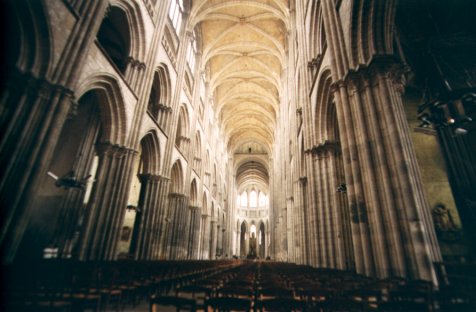The Sensory Paris
Today, we go to France for a meal that's too rich. The University of Houston's College of Engineering presents this series about the machines that make our civilization run, and the people whose ingenuity created them.
The English Channel is cold and rainy today -- heaving gray water under gray skies. The huge ferry boat is an English/French world. Few other countries are represented. As we leave New Haven, everyone speaks English. Near Dieppe, French accents intensify. Finally, people stop understanding my English. I begin recalling bits of schoolboy French. We debark and find a train to Rouen.
Here in Normandy, the iron armies of 1944 passed over like angels of death -- pulverizing the ancient towns. We walk by the tower where Joan of Arc was interrogated during another awful war, almost six centuries ago. We pass terrible WW-II bomb scars on the Hall of Justice, along the way to Rouen Cathedral.
The cathedral is stunning. The immense columns and arches distort and expand space. Its stone surely violates the law of gravity! The building assails the senses. We've entered a kind of fourth dimension, and I struggle to resolve it with reality.
But we see only fragments of the 15th-century stained glass. Only a pane here and half a window there has survived the bombings. Heads are blown off statues. After 50 years, the repairs still have far to go. A new window shows women in a grain field, one with a wide straw hat. They could as well be Vietnamese as medieval. They could be bystanders from any war.
After half an hour, the geometrical unreality, the poignant beauty, and the sense of violation by war grow too strong. I go back out into the quiet rain to clear my mind.
In a shop across the street I pay 100 francs for a frayed science book, published in 1745 -- a set of conversations on the senses. How do sight, touch, hearing, taste and smell work? What do they really tell us about reality? Here's Newton's new theory of light spectra and an early picture of the inner ear. Neither explains how vision and gravity failed me inside Rouen Cathedral.
Back in Paris we eat one last perfect pâté -- take one last walk among buildings whose physical beauty and elegance mock the mere shops and cafes they now house. Last week, we saw the museums here: rank on rank of Van Gogh, Monet, Rodin. In the Louvre, the Mona Lisa, Venus deMilo, and Winged Victory went by like pictures in Art Appreciation 101. Our senses grew numb.
It hit me in the Musée d'Orsay, amidst the Pre-Raphaelites and Art Nouveau. Suddenly the assault on the senses was too explicit. I dropped my guard and forgot to go numb. I had to flee to McDonald's on Rue St Germain for a cup of coffee. I had to find some blandness during a meal too rich for the taste buds.
It's time to go back to America and rebuild all this in my mind where I can contain it, cope with it -- make sense of it.
I'm John Lienhard, at the University of Houston, where we're interested in the way inventive minds work.
(Theme music)
Regnault, P., Les Entretiens Physiques d'Artiste et d'Eudoxe, ou Physique Nouvelle en Dialogues, Qui Renferme Precisément ce qui s'est Découvert de plus Curieux & de plus Utile dans la Nature. Vol. 3, 7th ed., revised and corrected. Paris: Chez David et Durand, 1745.

Photo by John Lienhard
In the Nave of Rouen Cathedral